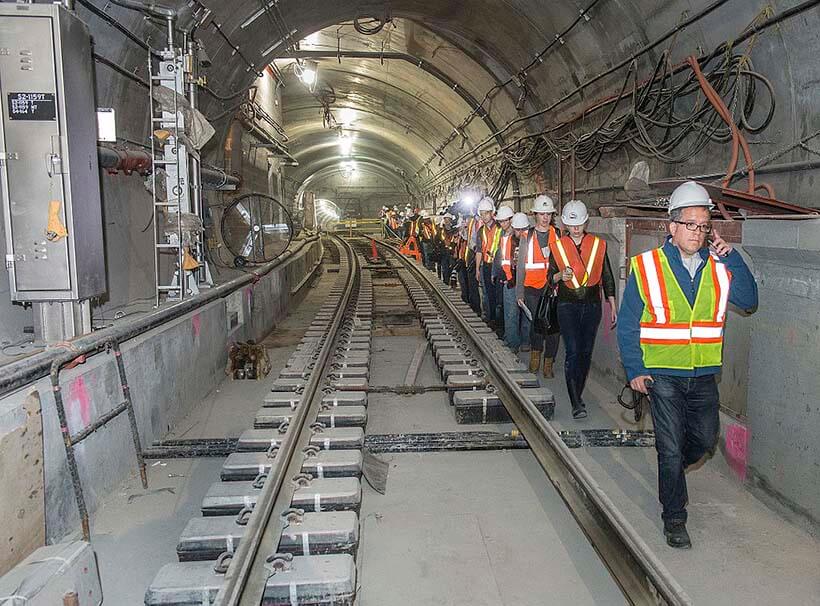Project News
E.E. Cruz Digs Deep on Second Avenue Subway Project

E.E. Cruz is constructing the 96th Street Station for the Second Avenue Subway in New York City as part of the Metropolitan Transportation Authority Capital Construction Program for owner MTA Transit. The $350 million project, a joint venture with Tully Construction, spans six blocks on Manhattan’s Upper East Side. The job, which began in 2009, is now more than halfway complete. The project involves major utility relocation, slurry wall construction, temporary curb-to-curb roadway decking installation, mass excavation and base slab construction.
Crews are currently constructing slurry walls on the east side of the street.
 “For a slurry wall, we dig a 120-foot-deep, 20-foot-long trench on either side of the street. As we dig, the hole is filled with bentonite, a slurry material, to hold it open and keep it from collapsing. Using a crane, we lower a reinforcing cage into the hole and pour the concrete, which displaces the slurry,” said E.E. Cruz project engineer Pablo LeMus. “The slurry wall is a major portion of the job.”
“For a slurry wall, we dig a 120-foot-deep, 20-foot-long trench on either side of the street. As we dig, the hole is filled with bentonite, a slurry material, to hold it open and keep it from collapsing. Using a crane, we lower a reinforcing cage into the hole and pour the concrete, which displaces the slurry,” said E.E. Cruz project engineer Pablo LeMus. “The slurry wall is a major portion of the job.”
“We’ve got about 33 of 47 wall panels to finish on this side,” explained Ed Codding, a project superintendent and 26-year veteran of E.E. Cruz.
Once the slurry walls are installed, crews will excavate 200,000 tons of soil and install a six-foot-thick structural concrete pad. This project will eventually connect to an existing subway tunnel built in 1972.
“The hardest part of the job is the complexity of New York City,” said E.E. Cruz assistant superintendent Kevin Brown. “We’re building a major infrastructure project in probably the most complicated place to build something in the entire country.”
The utility relocation alone took almost two years to complete.
Throughout the project crews have worked diligently to keep the sidewalks accessible; there is a constant flow of traffic, both on the streets and sidewalks of Second Avenue, which runs from downtown Manhattan to the Upper East Side.
The slurry wall rebar cages, measuring 10 feet wide by 80 feet long each, are built on-site, loaded onto a trailer with a massive gantry crane and transported several blocks through traffic.
 “Because it’s a linear job, we have to build cages a few blocks up. They’re only 10 feet wide, not the usual 20, because we have to transport them down Second Avenue. A 10-foot-wide, 80-foot-long cage coming down the street—no problem!” joked Ed.
“Because it’s a linear job, we have to build cages a few blocks up. They’re only 10 feet wide, not the usual 20, because we have to transport them down Second Avenue. A 10-foot-wide, 80-foot-long cage coming down the street—no problem!” joked Ed.
Once on location, each cage is lifted by a 200-ton crane and set into a slurry trench. Concrete is then tremie placed.
“Once a cage is set, we get a rebar delivery for the next panel,” said E.E. Cruz project manager Gus Lijo. “The work zone is constantly moving. The other crew keeps digging slurry walls, and we have to keep up with their pace.”
In many places only a sidewalk separates active operations from storefronts, high-rises and historic buildings along Second Avenue, some of which are more than 100 years old. It’s up to E.E. Cruz to protect the structural integrity of these fragile buildings. Small sensors on the facades of nearby buildings monitor in real-time any movement that could indicate an unstable foundation caused by nearby work.
“We’re excavating five feet from these buildings. It’s one of the major challenges, besides the utilities,” said E.E. Cruz senior vice president and project executive Charlie Montalbano.
One of the most striking features of the project is the launch box, a massive excavated area under the street created to give a tunnel boring machine access to drill the subway. The dark, damp, quiet space, some six stories below ground is a stark contrast to the busy street above.
“It’s the first time I’ve experienced anything like it,” said E.E. Cruz intern and College of New Jersey student Chuck Stewart. “My jaw dropped the first time I came down the steps. I’d never seen anything so colossal.”
The launch box was created under a separate contract, but E.E. Cruz is working to re-brace the structure to prepare for more excavation that will take place. Eventually the launch box will be connected to the current project.
Adrian Medeiros, the launch box superintendent, has worked underground for most of his 14 years with E.E. Cruz. “It’s big and a real challenge,” he said. “But I’ve been working underground for so long, it feels just like home.”
The project should be wrapped up in the summer of 2013. E.E. Cruz recently secured a second contract on the Second Avenue Subway, the final phase of construction. The new $324 million project will last three and a half years, overlapping with this job for one year.
The finished subway is expected to open to riders in the last quarter of 2016. MTA expects it will serve almost a quarter million riders daily.
